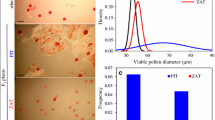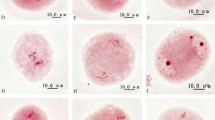Summary
Desynaptic mutants of diploid potato (2n=2x=24) were found to produce a fairly high frequency of fertile 2n pollen grains. Such 2n pollen grains may be expected to originate through an equational division of the entire chromosome complement, and therefore, of first division restitution (FDR) origin. Since second division restitution (SDR) gametes in desynaptic mutants are expected to abort, because of the imbalance of chromosome number, the fertile 2n gametes may constitute homogeneous populations of FDR gametes. Among a total of 306 progeny derived from six crosses 76 desynaptic mutants were detected. Of these, 23 mutants were found to have more than 20% pollen fertility. Some of these fertile mutants were successfully used as pollen parents.
Almost all the fertile mutants derived from crosses involving parents both of which produced 2n pollen. On the other hand, two crosses in which one of the parents was normal (producing only n pollen), with the other being 2n pollen producer, almost all the mutants were either male sterile or had below 20% pollen fertility.
Desynapsis was found to be controlled by a single recessive gene ds, but the inheritance of meiotic nuclear restitution appeared to be elusive.
Despite certain drawbacks that may arise from the use of desynaptic gene in a breeding programme. there are certain advantages as well.
Similar content being viewed by others
References
De Jong, H., G. C. C. Tai, W. A. Russell, G. R. Johnston & K. G. Proudfoot, 1981. Yield potential and genotype and environment interactions of tetraploid-diploid (4x−2x) potato hybrids. Am. Potato J. 58: 191–199.
Dowrick, G. J., 1953. The chromosomes of Chrysanthemum, III: Meiosis in C. atratum. Heredity 7: 218–226.
Gustafsson, A., 1935. Studies on the mechanism of parthenogenesiss. Hereditas 21: 1–111.
Hanneman, R. E.Jr. & S. J. Peloquin, 1969. Use of phureja and haploids to enhance the yield of cultivated tetraploid potatoes. Am. Potato J. 46: 436.
Hermsen, J. G. Th., 1977. Towords the cutivation in developing countries of hybrid populations of potato from botanical seed. Report Planning Conf. on the utilization of the genetic resources of the potato. 1977. Lima, Peru, 101–109.
Hermsen, J. G. Th., 1980. Breeding for apomixis in potato: pursuing an utopian scheme, Euphytica 29: 595–607.
Hermsen, J. G. Th. & M. S. Ramanna, 1981. Haploidy and plant breeding. Phil. Trans. R. Soc. Lond. B 292: 499–507.
Iwanaga, M. & S. J. Peloquin, 1979. Synaptic mutants affecting only megasporogenesis in potatoes. J. Hered. 70: 385–389.
Jacobsen, E., 1980. Increased diplandroid formation and seed set in 4x×2x crosses in potatoes by genetical manipulation of dihaploids and some theoretical consequences. Z. Pfl. Zücht. 85: 110–121.
Koduru, P. R. K. & M. K. Rao, 1981. Cytogenetics of synaptic mutants in higher plants. Theor. Appl. Genet. 59: 197–214.
Lamm, R., 1941. Varying cytological behaviour in reciprocal Solanum crosses. Hereditas 27: 202–208.
Matsubayashi, M., 1979. Genetic variation in diploid potato clones, with special reference to phenotypic segregations in some characters. Sci. Rep. Fac. Agric. Kobe Univ. 13: 185–192.
Mendiburu, A. O. & S. J. Peloquin, 1971. High yielding tetraploids from 4x−2x and 2x−2x matings. Am. Potato J. 48: 300–301.
Mendiburu, A. O. & S. J. Peloquin, 1977. Bilateral sexual polyploidization in potatoes. Euphytica 26: 573–583.
Mok, D. W. S. & S. J. Peloquin, 1975a. Three mechanisms of 2n pollen formation in diploid potatoes. Can. J. Genet. Cytol. 17: 217–225.
Mok, D. W. S. & S. J. Peloquin, 1975b. The inheritance of three mechanisms of diplondroids (2n pollen) formation in diploid potatoes. Heredity 35: 295–307.
Okwuagwu, C. O. & S. J. Peloquin, 1981. A method of transferring the intact parental genotype to the offspring via meiotic mutants. Am. Potato J. 58: 512–513.
Peloquin, S. J., 1982. Meotic mutants in potato breeding. Stadler Symp. 14: 1–11.
Ramanna, M. S., 1979. A re-examination of the mechanisms of 2n gamete formation in potato and its implications for breeding. Euphytica 28: 537–561.
Veilleux, R. E. & F. I. Lauer, 1981. Variation for 2n pollen production in clones of Solanum phureja Juz. and Buk. Theor. Appl. Genet. 59: 95–100.
Veilleux, R. E., N. A. McHale & F. I. Lauer, 1982. 2n Gametes in diploid Solanum: Frequency and types of spindle abnormalities. Can. J. Genet. Cytol. 24: 301–314.
Wagenaar, E. B., 1968. Meiotic restitution and the origin of polyploidy. II. Prolonged duration of metaphase I as casual factor of restitution induction. Can. J. Genet. Cytol. 10: 844–852.
Author information
Authors and Affiliations
Rights and permissions
About this article
Cite this article
Ramanna, M.S. First division restitution gametes through fertile desynaptic mutants of potato. Euphytica 32, 337–350 (1983). https://doi.org/10.1007/BF00021442
Received:
Issue Date:
DOI: https://doi.org/10.1007/BF00021442




